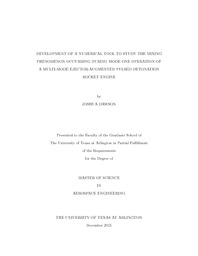| dc.description.abstract | A novel multi-mode implementation of a pulsed detonation engine, put forth by Wilson et al. [2], consists of four modes; each specifically designed to capitalize on flow features unique to the various flow regimes. This design enables the propulsion system to generate thrust through the entire flow regime. The multi-mode ejectoraugmented pulsed detonation rocket engine operates in mode one during take-o_ conditions through the acceleration to supersonic speeds. Once the mixing chamber internal flow exceeds supersonic speed, the propulsion system transitions to mode two. While operating in mode two, supersonic air is compressed in the mixing chamber by an upstream propagating detonation wave and then exhausted through the convergent-divergent nozzle. Once the velocity of the air flow within the mixing chamber exceeds the Chapman-Jouguet Mach number, the upstream propagating detonation wave no longer has sufficient energy to propagate upstream and consequently the propulsive system shifts to mode three. As a result of the inability of the detonation wave to propagate upstream, a steady oblique shock system is established just upstream of the convergent-divergent nozzle to initiate combustion. And finally, the propulsion system progresses on to mode four operation, consisting purely of a pulsed detonation rocket for high Mach number flight and use in the upper atmosphere as is needed for orbital insertion. Modes three and four appear to be a fairly significant challenge to implement, while the challenge of implementing modes one and two may prove to be a more practical goal in the near future. A vast number of potential applications exist for a propulsion system that would utilize modes one and two, namely a high Mach number hypersonic cruise vehicle. There is particular interest in the dynamics of mode one operation, which is the subject of this study. Several advantages can be obtained by use of this technology. Geometrically, the propulsion system is fairly simple and the rapid combustion process results in an engine cycle which is more efficient compared to its combined-cycle counterparts. The flow path geometry consists of an inlet system, followed just downstream by a mixing chamber where an ejector structure is placed within the flow path. Downstream of the ejector structure is a duct leading to a convergent-divergent nozzle. During mode one operation and within the ejector, products from the detonation of a stoichiometric hydrogen/air mixture are exhausted directly into the surrounding secondary air stream. Mixing then occurs between both the primary and secondary flow streams, at which point the air mass containing the high pressure, high temperature reaction products is convected downstream towards the nozzle. The engine cycle is engineered to a specific number of detonations per second, creating the pulsating characteristic of the primary flow. The pulsing nature of the primary flow serves as a momentum augmentation, enhancing the thrust and specific impulse at low speeds. Consequently, it is necessary to understand the transient mixing process between the primary and secondary flow streams occurring during mode one operation. Using OPENFOAM®, a numerical tool is developed to simulate the dynamics of the turbulent detonation process along with detailed chemistry in order to understand the physics involved with the stream interactions. The computational code has been developed within the framework of OPENFOAM®, an open-source alternative to commercial CFD software. A conservative formulation of the Farve averaged Navier-Stokes equations are used to facilitate programming and numerical stability. Time discretization is accomplished by using the Crank-Nicolson method, achieving second-order convergence in time. Species mass fraction transport equations are implemented and a Seulex ODE solver was used to resolve the system of ordinary differential equations describing the hydrogen-air reaction mechanism detailed in Appendix A. The Seulex ODE solution algorithm is an extrapolation method based on the linearly implicit Euler method with step size control. A second-order total variation diminishing method with a modified Sweby ux limiter was used for space discretization. And finally the use of operator splitting (PISO algorithm, and chemical kinetics) is essential due to the significant differences in characteristic time scales evolving simultaneously in turbulent reactive flow. Capturing the turbulent nature of the combustion process was done using the k-w-SST turbulence model, as formulated by, [1]. Mentor's formulation is well suited to resolve the boundary layer while remaining relatively insensitive to freestream conditions, blending the merits of both the k-w and k-E models. Further developement of the tool is possible, most notably with the Numerical Propulsion System Simulation application. NPSS allows the user to take advantage of a zooming functionality in which high-fidelity models of engine components can be integrated into NPSS models, allowing for a more robust propulsion system simulation. A more comprehensive understanding of the multi-mode ejector-augmented pulsed detonation rocket engine can be achieved with a systematic study of the impact pulsed flow has on thrust production. Although a significant increase in computational requirements, adding nozzle geometry to this study would illuminate any problems associated with pulsed flow through a nozzle. Additionally, a study including nozzle geometry would bring more clarity in regards to the efficiency of the propulsion design. | |


